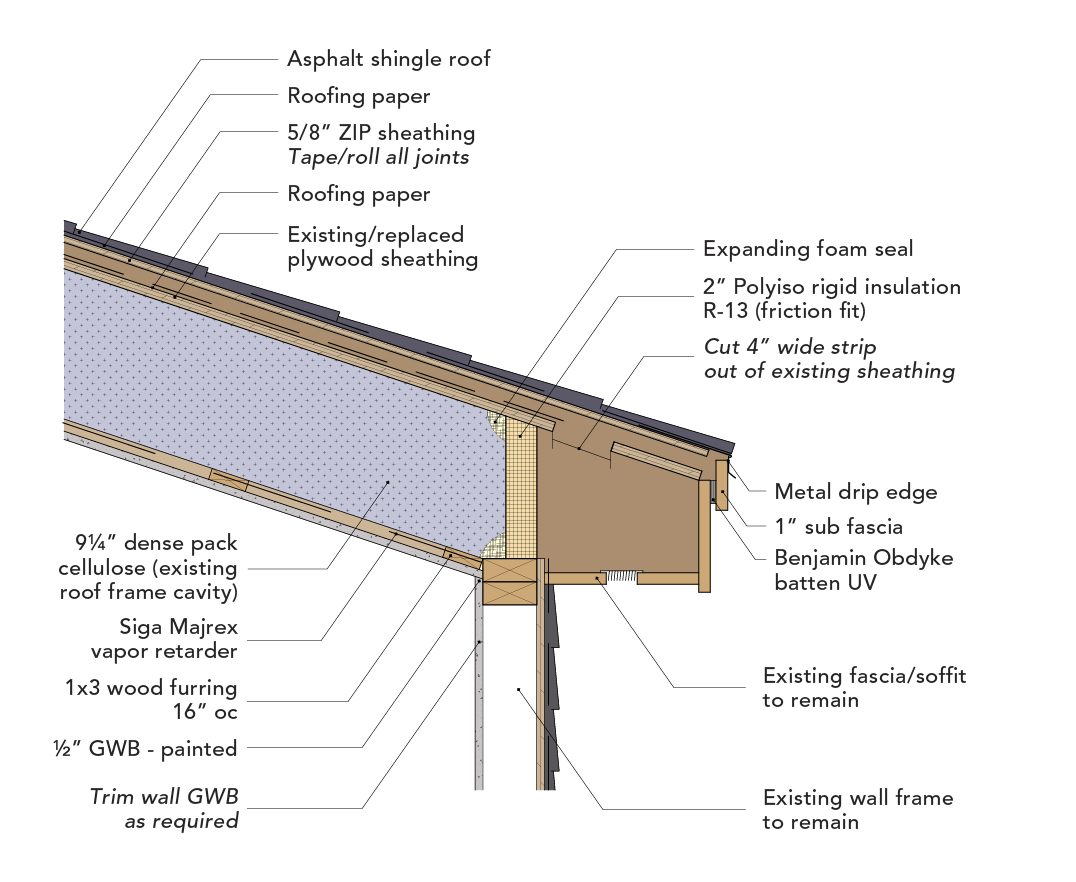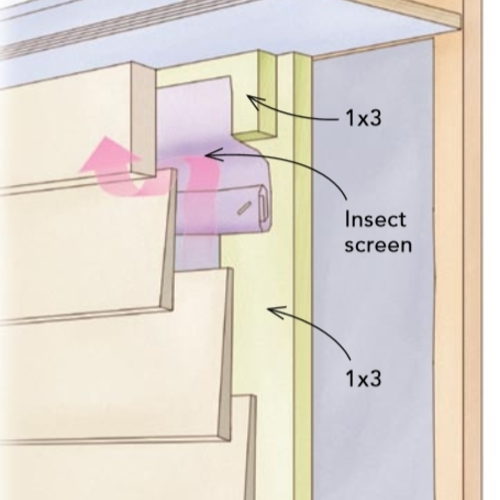
Jonathan Sinclair’s home, a 225-year-old timber frame in New Hampshire, is getting a facelift. Sinclair is residing the building with fiber-cement lap siding, and he plans to install the siding over a vented rainscreen—a thoroughly modern detail.
“My question comes from building an adequate soffit vent that will flow air,” Sinclair writes in this recent Q&A post.
As he explains, the original builder included 2×6 soffits with a 2 1/2-inch-wide gap between the building and the edge of the soffit. That gap was then covered with molding. Sinclair plans to incorporate this gap into the top of his rainscreen so that air will have a continuous path from the bottom of the house to the attic. Ridgevent 20 (manufactured by Air Vent Inc.) at the top and bottom of the rainscreen will keep out the bugs.
“Does anyone have an opinion if this will allow adequate air flow to act as a soffit vent or will I need to drill holes up through the soffit beyond the crown molding through the 2×6 to give adequate soffit venting,” Sinclair asks. The house has no ridge vents and but it does have gable-end vents at the peak.
Venting the rainscreen into the attic is OK
GBA editor Brian Pontolilo replies that it’s generally fine to vent a rainscreen into an attic, although Sinclair’s building inspector may have other ideas. If the inspector is okay with it, there is still the question of whether it provides an adequate amount of intake area for effective roof venting.
The International Residential Code (IRC) does include some guidance on how to calculate what’s called the “net-free ventilating area” for a roof, which you can read more about here. Pontolilo also suggests an earlier GBA article on the topic (see the first entry in the “Related…
Weekly Newsletter
Get building science and energy efficiency advice, plus special offers, in your inbox.

This article is only available to GBA Prime Members
Sign up for a free trial and get instant access to this article as well as GBA’s complete library of premium articles and construction details.
Start Free TrialAlready a member? Log in















20 Comments
Interesting. A moisture problem in a new home testing at 1.2ACH50. My noob expectation would be 1.2 ACH50 ... we're good to go, no worries here.
Yes, me too. I guess it's good reminder that tight houses can still have large enough localized air-leakage to cause problems.
I would be happy to provide Scott Gibson with additional pictures of the rainscreen details and soffit system that I constructed if he could contact me. I have attempted to find his email or contact info through google searches and reaching out to Fine Home Building but I haven’t gotten a response.
Here's my email.
Jonathan—You can reach me at scottgibson51 (at) gmail (dot) com.
Scott
> closing off the top means that (more buoyant) warm moist air collects at the top
Don't block off the top where reservoir cladding and solar drive pushes moisture into the cavity. And keep paint perms > 10.
https://www.buildingscience.com/documents/building-science-insights/bsi-061-inward-drive-outward-drying
I appreciate the response. From what I am understanding about the perm rating, you feel as though the perm rating of tyvek at 50-60 is to high for this application?
Jonathan,
The problems with inward solar vapour drive depend on the amount of water that can be held by the cladding. Painted siding would not be considered by most people to be a reservoir cladding with worrying about.
Thank you for the insight!
Joe L says "So what is a reservoir cladding? ... Fiber cement? Yes, unless you paint it or coat it on all six sides…and even then. "
I'd like to see numbers, but in any case, I'd go with the expert and use lower perms (like Typar) where there are high perms all the way to a cool surface (which may not apply in this case). Fully adhered moderate perm WRB if needed to stop airflow.
The fiber cement siding is primed in all 6 sides. So atleast it should abosorb very little in my mind.
The Hardie Panel I installed (and trim and battens) was only painted on five sides (not the back).
Trevor, interesting point you bring up. I always was under the impression from hardi that the back was also primed since the color is more or less the same but it is rough in texture so I thought that was the reason for the color inconsistencies. Turns out that there is some primer on the back from the rollers at the factory but it is not straight coated like the other 5 sides. I did some more research and hardi claims you don’t need to prime the back or top cost it because of their primer which is mixed in with the mix? Interesting subject.
I have almost completed the project at this point. The only things I have left are a second coat of Sherwin Williams Emerald and the top facia shadow board which will go on after the pump jack brackets come off. Below are pictures of the rain screen strapping, pre assembled pvc window trim and ledger board with solid blocking out to existing facia boards.
Additional pictures of the soffit framing, bug screen to keep insects out of the attic and the top nailer for the frieze board.
Top solid nailer, Air Vent brand ridge vent. It into 2 inch strips and nailed in between strapping for vent/bug screen, frieze board notched to drop over the top of the top of the siding and allow an air path.
Frieze board across the top nailer and notched for air vent, solid nailer attached for crown molding backer.
Nice job!
Thank you sir.
Crown molding up( I would have gone with 4 1/2 inch crown for more air flow but 5 1/2 matched the original crown), first coat of paint.
The project is complete with two coats of Sherwin Williams Emerald. The last piece is the top shadow board for the facia that needs to be scribed and cut to slide up into place.
Log in or become a member to post a comment.
Sign up Log in